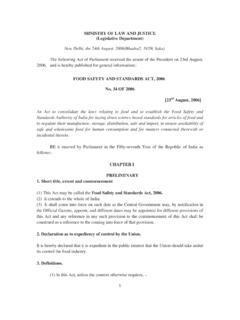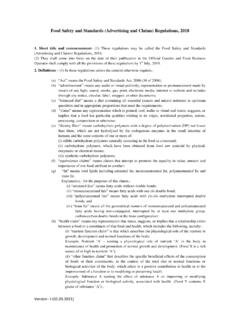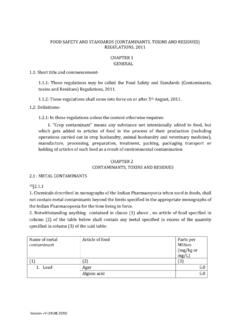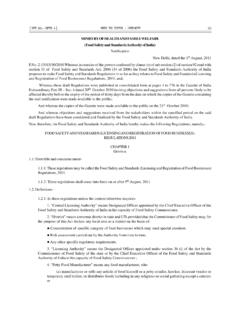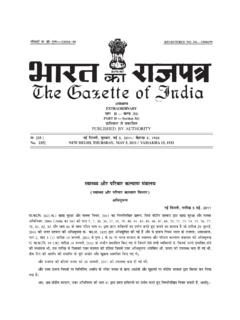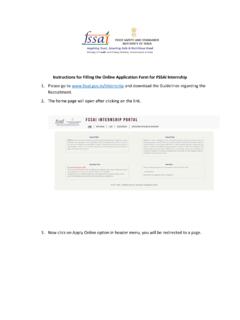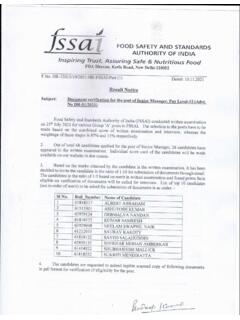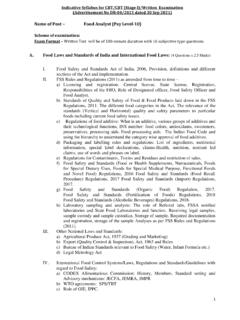Transcription of FOOD SAFETY AND STANDARDS (FOOD PRODUCTS …
1 Version-XII ( ) food SAFETY AND STANDARDS ( food PRODUCTS STANDARDS AND food additives ) REGULATIONS, 2011 CHAPTER 1 general : Title and commencement :These regulations may be called the food SAFETY and STANDARDS ( food PRODUCTS STANDARDS and food additives ) Regulations, 2011. : These regulatiions shall come into force on or after 5th August, 2011, except regulations, (1)(2)(3), (1)(2)(3)(4), (1) and entries relating in table 14 of appendix A and table 2 of appendix B, which shall come into force after six months from that date and in regulation (1)(3) and (1)(2) only relating entries in table which shall come into force after six months from that date.
2 Provided that wherever the STANDARDS given in these regulations are at variance with any of the provisions of the licenses already granted, food Business Operator shall comply with the provisions of these regulations towards the STANDARDS relating to caramel and glazing agents within Forty two months 5th February, 2015 from the date of commencement of these regulations. : Definitions In these regulations unless the context otherwise requires: 1. 38[omitted]. 2. De-oiled meal means the residual material left over when oil is extracted by a solvent from any oil-bearing material; 3. 38[omitted]. 4. Hydrogenation means the process of addition of hydrogen to an edible vegetable oil using a catalyst to produce a fat with semi-solid consistency; 5.
3 38[omitted]. 6. 38[omitted]. 7. Irradiation means any physical procedure, involving the intentional exposure of food to ionizing radiations. 8. Irradiation facility means any facility which is capable of being utilized for treatment of food by irradiation. 9. Irradiated food means articles of food subjected to radiation by : (i) Gamma Rays; (ii) X-rays generated from machine sources operated at or below an energy level of 5 million electron volts; and (iii) Sub-atomic particles, namely, electrons generated from machine sources operated at or below an energy level of 10 million electron volts, to dose levels as specified in Schedule I of the Atomic Energy (Control of Irradiation of food ) Rules 1991.
4 10. 38[omitted]. 11. 38[omitted]. Version-XII ( ) 12. 38[omitted]. 13. Margarine means an emulsion of edible oils and fats with water; 14. Operator of irradiation facility means any person appointed as such by licensee who satisfies the qualifications and requirements as for training specified in Schedule II of the Atomic Energy (Control of Irradiation of food ) Rules, 1991 15. 38[omitted]. 16. 38[omitted] 17. Refined vegetable oil means any vegetable oil which is obtained by expression or solvent extraction of vegetable oil bearing materials, deacidified with alkali and/or by physical refining and/or by miscella refining using permitted food grade solvents and/or degumming followed by bleaching with absorbent earth and/or activated carbon and deodorized with steam without using any other chemical agents 18.
5 Refining means a process by which an expressed vegetable oil or a solvent-extracted oil is deacidified (i) With alkali, or (ii) by physical refining, or both, or (iii) By miscella refining using permitted food grade solvent, followed by bleaching with absorbent earth and/or activated carbon or both of them and deodorized with steam without using any other chemical agent; (iv) refining if required may include the process of degumming using phosphoric/citric acid 26[and any suitable food grade enzyme]. 19. 38[omitted]. 20. 38[omitted] 21. 38[omitted] 22. Solvent-extracted oil means any vegetable oil obtained from oil-bearing material by the process of extraction by a solvent; 23. Solvent-extracted edible flour means the ground material obtained from specially prepared deoiled meal, that is, the residual material left over when oil is extracted by a solvent from oil cake immediately following the single-pressing of good quality edible oilseeds; 24.
6 38[omitted] 25. Vegetable oils means oils produced from oilcakes or oilseeds or oil-bearing materials of plant origin and containing glycerides; 26. Vegetable oil product means any product obtained for edible purposes by subjecting one or more edible oils to any or a combination of any of the processes or operations, namely, refining, blending, hydrogenation or interesterification and winterization (process by which edible fats and oils are fractioned through cooling), and includes any other process which may be notified by the Central Government in the official Gazette; CHAPTER 2 food PRODUCT STANDARDS 38[ DAIRY PRODUCTS AND ANALOGUES general STANDARDS for Milk and Milk PRODUCTS The general standard provides over-arching definitions for milk and milk PRODUCTS and guidance on Version-XII ( ) the use of dairy terms in relation to foods to be offered to the consumer or for further processing.]
7 1. Definitions. - (a) Boiling, boiled and similar terms when used in association with milk, shall be taken to refer to the process of heating milk continuously to bring it to boil at atmospheric pressure; (b) Composite milk product means a product of which the milk, milk PRODUCTS or milk constituents shall be an essential part in terms of quantity in the final product, as consumed: Provided that the constituents not derived from milk shall not take the place in part or in whole of any milk constituent. Examples of composite milk PRODUCTS are: (i) Shrikhand with fruits etc.; (ii) ice cream containing fruits etc.; (iii) flavoured fermented milks; (iv) Drinks based on fermented milks (c) Dairy terms means names, designations, symbols, pictorial or other devices which refer to or are suggestive, directly or indirectly, of milk or milk PRODUCTS ; (d) Heat treatment means pasteurization, ultra-pasteurization, sterilisation, ultra-high temperature treatment or boiling; (e) Milk means the normal mammary secretion derived from complete milking of healthy milch animal, without either addition thereto or extraction therefrom, unless otherwise provided in these regulations and it shall be free from colostrum.
8 (f) Milk Product means a product obtained by processing of milk, which may contain food additives and other ingredients functionally necessary for the milk product as permitted in these regulations and shall include the following, namely:- (i) cheese; (ii) chhana, skimmed-milk chhana, paneer; (iii) condensed milk-sweetened and unsweetened; (iv) condensed skimmed milk-sweetened and unsweetened; (v) cream; (vi) curd, skimmed milk curd, dahi; (vii) ghee, butter oil; (viii) ice-cream; (ix) infant milk food ; (x) khoa; (xi) malai; (xii) milk derivatives such as whey proteins, casein, lactose etc.; (xiii) milk ices, milk lollies, kulfi; Version-XII ( ) (xiv) milk powder, skimmed milk powder, partly skimmed milk powder; (xv) processed cheese; (xvi) table butter and white butter; (xvii) yoghurt; (xviii) any other product as may be specified in these regulations: Provided that milk PRODUCTS shall not contain any substance not found in milk unless specified in these regulations; (g) Pasteurization, Pasteurized and similar terms means a microbicidal heat treatment aimed at reducing the number of any pathogenic micro-organisms in milk and liquid milk PRODUCTS , if present, to a level at which they do not constitute a significant health hazard.
9 Pasteurization conditions shall be designed to effectively destroy the organisms Mycobacterium tuberculosis and Coxiella burnettii. Pasteurization, when used in association with milk, shall be taken to refer to the typical process of heating every particle of milk to at least 630C and holding at such temperature continuously for at least thirty minutes or heating it to at least 720C and holding at such temperature continuously for at least fifteen seconds, or any other temperature-time combination, sufficient to give a microbicidal effect equivalent to the above defined temperature-time combination and serve to give a negative Phosphatase Test that is applicable to milk immediately after pasteurization only, and cooling it immediately to a temperature of 40C, or less.
10 (h) Recombined milk or milk product means a product resulting from the combination of milk fat and milk-solids-non-fat in their preserved forms with or without the addition of potable water to achieve similar end product characteristics and appropriate milk product composition as per the Standard for that product and in the case of recombined milk, the source of milk-solids-non-fat shall be dried or concentrated milks only; (i) Reconstituted milk or milk product means a product resulting from the addition of potable water to the dried or concentrated form of milk or milk PRODUCTS in the amount necessary to re-establish the appropriate water-to-solids ratio to achieve similar end product characteristics and appropriate milk product composition as per the STANDARDS for that product; (j) Sterilisation, sterilised and similar terms means application of heat at high temperatures for a time sufficient to render milk or milk PRODUCTS commercially sterile, thus resulting in PRODUCTS that are safe and microbiologically stable at room temperatures.
